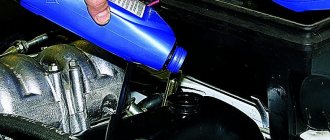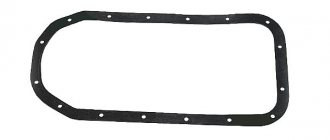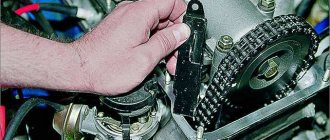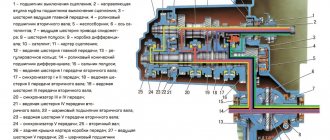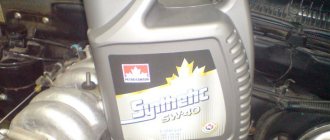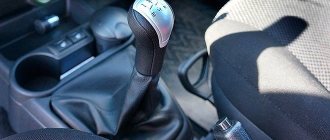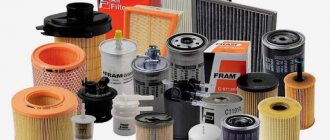Any vehicle needs technical support. The equipment will work successfully only in cases where all mechanisms function without failure. Any motorist knows that the engine will not work if the appropriate motor oil is not poured into it in a timely manner. However, not only the car engine, but also the gearbox needs oil fluid. The process of changing the oil poured into a Chevrolet Niva transmission is not complicated, however, it is certainly necessary to prepare for it and arm yourself with the necessary theoretical knowledge. Many motorists believe that it is best to turn to professionals who will perform such tasks quickly and with the highest quality. This is partly true, but in order to save money, you should not contact a service station; it is better to do everything yourself. We will help you understand the intricacies of the procedure.
How to properly change the oil in a Chevrolet NIVA gearbox.
Functioning of the checkpoint
The Niva Chevrolet gearshift mechanism is five-speed mechanical. Its main function is to change the torque transmitted from the engine to the wheels. The manual transmission has a three-shaft design. Unfortunately, the Niva Chevrolet gearbox, having a complex design, often fails. It should be noted that its repair is quite expensive. Therefore, it is important to periodically check the lubricant level and change the oil in the gearbox on time.
For this purpose, transmission fluid of API GL-4 standard with viscosity of 75W-90 and 80W-90 is used. They are produced by both domestic manufacturers (TNK and Lukoil) and foreign ones - Shell, Mobil, Castrol, Total, ZIC, Motul. Of all the above, the French lubricant Motul Gear 300 75W-90 showed the best performance in terms of protection against scuffing, film stability on contacting surfaces, and anti-wear characteristics.
In second place was Castrol Syntrans Transaxle 75W-90 transmission fluid, third was Mobil Mobilube 75W-90 oil. All of them can operate at temperatures from -35 to +35°C, ensuring easy gear shifting and stable operation of the manual transmission. The price of these products is quite high, so it is worth paying attention to the domestic semi-synthetic transmission made by Lukoil - TM-4 75W-90. It is not much inferior to foreign competitors, but at the same time it is much cheaper and better adapted to low temperatures. The manufacturer also allows the use of transmission fluids of viscosity 80W-90 and 80W-85.
It should be remembered that you cannot fill the gearbox with API GL-5 standard transmission oil. In terms of its performance, it seems to be better - it can operate at high speeds and loads, as well as high temperatures. But it contains sulfur-phosphorus extreme pressure additives, a large amount of which can simply “kill” the gearbox synchronizers. They contain bronze, not durable steel. A large number of such additives are contraindicated for her. Therefore, compositions of the GL-5 standard should be poured into axles and gearboxes.
Chevrolet Niva filling volumes
Some people use very thin oils 0 – 40, but they cost much more and won’t make much of a difference.
If the car engine does not have hydraulic compensators, you can use 10 - 40 regardless of the season, and in the case of hydraulic compensators, fill in 5 - 40. The number of these elements in each car may vary. In addition, it is important to have a clear understanding of the location, types, engine and transmission oil used, types of lubricants and fluids.
- After all, Chevrolet Niva filling tanks must be filled taking into account the plant’s recommendations so that all systems can fully operate.
- Video
FILLING CAPACITIES
| Refillable system | Volume, l |
| Fuel tank (including reserve) | 42 (65*) |
| Engine cooling system (including interior heating system) | 10,7 |
| Engine lubrication system (including oil filter) | 3,75 |
| Gearbox housing | 1,6 |
| Rear axle housing | 1,3 |
| Steering gear housing | 0,18 |
| Transfer case housing | 0,79 |
| Front axle housing | 1,15 |
| Hydraulic clutch system | 0,2 |
| Hydraulic brake system | 0,535 |
| Windshield and headlight washer reservoir | 2,8 |
| Rear window washer reservoir | 2,0 |
| Power steering reservoir | 1,7 |
* For VAZ-2131 cars and its modifications.
| Refueling or lubrication point | Quantity, l | Name of materials |
| Fuel tank | 42 | Motor gasoline with octane number 91–93, 95* |
| Engine cooling system including interior heating system | 10,7 | Coolant with a freezing point no higher than –40°C |
| Engine lubrication system, including oil filter, at ambient temperature: | 3,75 | Motor oils (with API quality level: SG, SH, SJ) |
| from –20° to 45°С | SAE 15W-40 | |
| from –25° to 35°С | SAE 10W-30 | |
| from –25° to 45°С | SAE 10W-40 | |
| from –30° to 35°С | SAE 5W-30 | |
| from –30° to 45°С | SAE 5W-40 | |
| Gearbox housing | 1,35 | Gear oils with quality level according to API GL-5 and viscosity 75W-90 |
| Transfer case housing | 0,75 | |
| Front axle housing | 1, 15 | |
| Rear axle housing | 1,3 | |
| Steering gear housing | 0, 18 | Gear oil 75W-90 |
| Hydraulic clutch release system Hydraulic brake system | 0,2 0,515 | Brake fluid DOT-3, -4 |
| Windshield washer reservoir Tailgate washer reservoir | 2,0 (5,0) | A mixture of water and windshield washer fluid |
| Starter drive drive ring | — | Litol-24 lubricant or imported analogues |
| Front wheel bearings | — | Litol-24 lubricant or imported analogues |
| Cardan joint cross bearings | — | Lubricant Fiol-2U, No. 158 or imported analogues |
| Front propeller shaft spline | — | Lubricant Fiol-1, CV joint-4 or imported analogues |
| Door limiters | — | Grease Shrus-4 |
| Seat moving slides | Fiol-1 lubricant or imported analogues | |
| Tie rod joints and front suspension ball pins | — | ShRB-4 lubricant or imported analogues |
| Battery leads and terminals, door keyholes | Automatic lubricant VTV-1 in aerosol packaging, CIATIM-201, -221, Litol-24 or imported analogues | |
| Door locks | — | Fiol-1 lubricant or imported analogues |
| Rear brake pressure regulator | — | Lubricant DT-1 or imported analogues |
*For vehicles with fuel injection system equipped with an exhaust gas converter
- FILLING CAPACITIES, OILS AND LIQUIDS.
- Oils and liquids
- Motor gasoline with octane number 93, 95**
- Engine cooling system
- (including interior heating system)
- Coolant with a freezing point no higher than –40°C
- Latest recommendation from AvtoVAZ
- Sintec Antifreeze Lux G12
- Engine lubrication system
- (including oil filter)
- Motor oils (with API quality level: SG, SH, SJ, SL,SM, SN)
- Gearbox housing
- Gear oils with quality level according to API GL-5 and viscosity 75W-90
- Rear axle housing
- Steering gear housing
- Transfer case housing
- Front axle housing
- Hydraulic clutch system
- DOT-4 brake fluid
- Hydraulic brake system
- Windshield and headlight washer reservoir
- A mixture of water and windshield washer fluid
- Rear window washer reservoir
- Power steering reservoir
- Fluid for refilling the hydraulic steering system Pentosin SHF11S
- * For VAZ-2131 cars and its modifications.
- **For vehicles with fuel injection system equipped with an exhaust gas converter
Also interesting: How to tighten or replace the handbrake on a Chevrolet Niva.
This recording is more for myself, but maybe it will be useful for someone else. Since after the purchase I only changed the oil in the engine, and it’s not at all clear what and how much in the transmission, I’m thinking about changing the oils in the gearbox, transfer case and axles. It would be good to know what kind of transmission oil to fill in to reduce the howling of the transfer case.
Fuel tank 58.
0 l Engine cooling system 8.0 l Engine lubrication system 3.75 l Gearbox housing 1.6 l Transfer case housing 0.79 l Front axle housing 1.15 l Rear axle housing 1.3 l Brake hydraulic system 0.5 l Clutch release hydraulic system 0.15 Windshield washer reservoir 5.0 l Tailgate washer reservoir 2.0 l Front shock absorber 0.15 l Rear shock absorber 0.215 l Power steering 1.7 l Air conditioning: refrigerant 0.650 kg
Conditioner: oil 0.22 l
- Places for lubrication, filling, processing
- Motor oils type SUPER (classification according to SAE; API) Engine lubrication system Viscosity class according to SAE: 5W-30: from –25 to 20 С5W-40: from –25 to 35 С10W-30: from -20 to 30 С10W -40: from -20 to 35 С15W-40: from –15 to 45 С20W-40: from –10 to 45 Level of performance properties: according to API SG, SH, SJ according to ASEA A2
- according to CCMC G3, G4
- Transmission oils (classification according to SAE; API) Gearbox, Transfer case Viscosity grade according to SAE: 75 W-90; 80 W-85; 80 W-90; Level of performance properties: according to API: GL-4 or universal: GL-4/ GL-5 Front axle, Rear axle, Steering gear Viscosity grade according to SAE: 80 W-90; 85 W-90; Level of performance properties: according to API: GL-5 or universal: GL-4/ GL-5
- Power steering: Pentosin Hidraulik Fluid CHF11S VW52137
How to avoid falling asleep while driving on the highway
GreasesFront wheel drive joints CV joints-4M, SPECTROL CV joints MoS2 TU 0254-001-0014882Front suspension ball joints, Steering rod joints ShRB-4 TU 38.
USSR-201-143 Joints for cardan shafts Litin 2 TU 0254-311-00148820 Splined joints for cardan shafts 158 TU 38.
Dowcorning
Pressure regulator DT-1 TU 38-USSR-201-116
Brake and clutch hydraulic drive system Brake fluids type DOT-4 SAE J 1703, FMSS116
In this article we will talk about how to change the oil in the gearbox, transfer case and axles of a Chevrolet Niva. The use of high-quality lubricants for vehicles plays an important role in the operation of any car. The most common process for proper vehicle operation is the oil change process. It is possible to change the oil yourself, without resorting to the help of auto service employees, while significantly saving money.
Choosing engine oil is a responsible task on which the service life of the power plant depends. This procedure is no less important than the oil change process itself. Oil should be selected according to the parameters and tolerances specified in the operating instructions.
You cannot make a mistake in your choice, as this mistake can result in a serious technical breakdown, and incompatible oil can cause a major overhaul of the engine.
In this article, using the example of the popular Chevrolet Niva SUV, we will pay attention to the most important parameters of motor oil, and also consider the best brands of oils and how much oil should be filled.
Lubricants consist of a base (base) and additives. Their chemical and physical properties depend on the composition and origin of these components.
According to the method of manufacturing the base, the transmission is divided into three types:
- Mineral is a product remaining after the distillation of oil in the production of diesel fuel and gasoline. Includes heavy fractions of hydrocarbons and contains large amounts of sulfur. Its properties are determined by naphthenes, aromatics and paraffins. The oil entering oil refineries differs in its composition. This does not allow achieving stable mixture proportions. Therefore, the final parameters are adjusted with additives. Under the influence of temperature, heavy fractions of hydrocarbons disintegrate, and additives oxidize and lose their properties. This oil has to be changed more often. Another disadvantage of “mineral water” is that oxidation products settle on parts.
- The synthetic base is artificially created from the desired hydrocarbons. Thanks to this, it is possible to obtain a product with predictable viscosity values without the use of additives. Additives are used only to improve the lubricating and antioxidant properties of the transmission.
- Semi-synthetic oils are created on the basis of a mixture of mineral and synthetic bases (at least 30% of the latter is used). This approach allows you to reduce the number of additives that change viscosity.
And also interesting: We are installing an engine on a Niva from a foreign car. It's worth it "
Synthetic gear oil differs from mineral and semi-synthetic oil in that its viscosity changes less with temperature changes. This reduces wear on transmission parts during winter operation of the Chevrolet Niva. But “synthetics”, due to their greater fluidity, seep through worn gearbox seals more easily.
However, the main characteristic of a lubricant is viscosity. This is what is indicated in the operating instructions. The manufacturing company recommends filling in the following types of gear oils (according to SAE):
- Transfer case and gearbox - 75W-90, 80W-85, 80W-90.
- Drive axles (front and rear) - 80W-90, 85W90.
Therefore, API GL4 and GL4/GL5 must be poured into the gearbox (gearbox), and GL4/GL5 and GL5 into the axles and transfer case.
There are dozens of gear oil brands on the market. The most famous imported ones are Castrol, Liqui Moly, Mobile, Shell, and the most famous domestic ones are Lukoil and Rosneft.
Transfer case
This is another important transmission unit of the Chevrolet Niva. It includes a range multiplier and a lockable center differential. The transfer case also changes the amount of torque, but not in the same way as the gearbox. In addition, it distributes it between the axles, front and rear, maintaining a 50:50 ratio. The differential is locked to improve maneuverability if road conditions are very difficult.
The transfer case (in the picture its lever is 2) can be switched similarly to a gearbox, only the purpose of the lever shifts is completely different. There is a neutral position (NII–V). There is a high gear (HI) used for normal road conditions, with the differential unlocked. If it needs to be blocked, transmission (HIV) is activated. In difficult areas, the lever switches to LIII if the differential does not yet need to be locked. If it’s really difficult to drive, you need to switch to LIV, blocking the bridges between them. The wheels then rotate at the same speed.
You can switch from the Low position (L - low gear) to the High position (H - high gear) while driving. In this case, you should squeeze the clutch twice, because the transfer case does not have synchronizers. Switching from H to L positions is only possible after the vehicle has stopped. In addition, you cannot lock the differential at high speeds, as you can lose control of the car when cornering. The transfer case uses the same gear oil that is used for the gearbox.
Communities › Chevrolet Niva › Blog › Leaking gearbox
Dear friends, help me understand what it is, I noticed an oil stain not long ago at the junction of the gearbox and the internal combustion engine
, also noticed a wet place where the gear shift rod
, mileage 35 thousand km, noticed 5 thousand km ago, oil in both the internal combustion engine and the gearbox is at the normal level
, there is no extraneous noise, the gears engage perfectly, I blame the input shaft seal. The question is, is it worth climbing in and removing the box just because of this?
and What are the mounts for on the left side (in the direction of travel) on the gearbox?
Changing the lubricant in the manual transmission
The first oil change in the gearbox after purchasing a car is done after 60,000 km. The next time you will need to change the oil is after 45,000 km. In the future, this interval will have to be observed constantly.
How much oil do you need to fill? To optimally fill the oil into the box, you will need a transmission fluid volume of 1.6 liters. It is most convenient to immediately change the lubricant in the transfer case, since they have the same service life.
Why and when do you need to change the oil?
The Niva's gearbox needs to be regularly refilled with new oil as part of scheduled maintenance, since transmission fluid is prone to wear and requires replacement from time to time. The gearbox in a car is responsible for changing the engine torque and adjusting the transmission of motion to the drive axles. A serviceable gearbox effectively regulates traction and speed characteristics over a significant range, allowing the engine to operate as productively as possible.
Changing the oil in the Niva 21214 gearbox is a simple procedure, but you must follow a number of rules. If everything is done correctly, the unit will last for many years and there will be no serious problems with it. Only one fluid is used for axles and transfer case; be sure to take into account the manufacturer’s recommendations when choosing.
Fresh, high-quality oil is yellow in color, free of foreign impurities and a sharp burnt odor.
The Niva 21213 gearbox needs to be refilled with new oil on average every 50 thousand km, but this is a conditional interval, the exact interval depends on a number of factors. In the boxes of machines operating in difficult conditions, destructive processes can begin, and the fluid will eventually fail much earlier than it could. To understand whether it is time to pour new gear oil into the Niva gearbox or not, checks are done. You need to pay attention to color, smell, and the presence of foreign inclusions. If the transmission fluid has changed its characteristics significantly, we can talk about its significant wear.
The Lada 4x4 transmission oil will last longer if you follow these simple recommendations:
- Reduce the speed of movement to approximately 100 km/h, make acceleration smooth.
- When using a manual, squeeze the clutch very smoothly, and when using an automatic, carefully shift the selector.
- Regularly inspect surfaces for leaks and oil smudges. If they are detected, a comprehensive diagnosis of the system is carried out at a service station.
- Add oil to the Niva box in a timely manner if its level is less than required.
Taking into account the described recommendations will increase the service life of the fluid and box several times. The replacement procedure is carried out at a service station or on your own - depending on the skill and experience of the driver. Most vehicle owners do the work themselves to save money.
Changing the oil in the transfer case
We change the oil inside the transfer case in a similar way. For work, you should prepare the same materials and lubricant, but washing is not necessary.
You also need to warm up the car’s transmission and drive either onto an overpass or into a viewing hole.
- The filler plug is unscrewed.
- A container is placed to receive the waste liquid.
- The drain plug is unscrewed and the liquid is drained to the last drop.
- The magnet of the plug is cleaned of metal shavings.
- Approximately 1 liter of lubricant is poured with a syringe until its level reaches the filler hole.
- The filler plug is tightened, the operation of the ventilation valve is checked, and it is cleaned if necessary.
At this point, all operations for changing the oil inside the gearbox, as well as the transfer case, are completed. You can drive another 45,000 km until the next replacement.
The procedure for filling a Chevrolet Niva transmission with oil is available even for novice drivers. The main condition is compliance with vehicle maintenance regulations, which guarantees the serviceability and uninterrupted operation of gearbox units. The choice of transmission oil for manual transmissions of the Chevrolet Niva, Niva 21213, VAZ 2131 is carried out in accordance with the manufacturers' recommendations. The necessary information about the most suitable brand of transmission oil is contained in the service books for a specific vehicle.
Oil leaks in the rear of the gearbox - logbook of the 2008 Chevrolet Niva on DRIVE2
Back in the fall, I saw oil in the area of the secondary shaft, and around the shank itself it was more or less dry - you can immediately see that it was not leaking from it. I replaced the reverse sensor because it was covered in oil and looked suspicious. But as it turned out, it wasn’t his fault. It was worth looking a little higher, to where the gear shift lever is located, covered with anther, and everything would immediately become clear. But I didn’t even imagine that so much oil could leak from such a high point... Now, after a while, the gap widened and it was already hanging in such large drops from below on the box.
You can get to this boot without removing the gearbox, and in general this is a trivial task if you don’t unscrew too much and don’t create problems for yourself (like me, heh).
1. First you need to unscrew the rear support of the box. To remove it without removing the front axle cardan, you need to unscrew the rubber cushion from the bracket and, lifting the box with a mounting tool, pull it out in parts. To do this, you will also have to unscrew the nut from one of the bolts that secures the rubber coupling of the intermediate shaft (it does not allow the cushion to be removed from the studs).
2. After this, we put marks on both ends of the groove so that we can put everything back in its old place. We tighten the rubber coupling with a clamp, thereby weakening the pressure of the rubber on the bolts. If you wish, you can pull them out without a tie, but it will be difficult to put them back in. If you don’t have such a large clamp, you can connect several in series or tie them together with wire.
3. Unscrew the remaining two nuts with which the coupling is screwed to the shank (do not unscrew the extra ones while parked) and the four on the side of the transfer case. We take out the shaft assembly by pressing it with a mounting tool - it should shrink at the spline joint (if it has not soured).
4. In the cabin, pull out the gear shift knob, loosen the adjusting clamp from below and unscrew the entire shift mechanism (link).
5. Now you can get to the hero of the occasion. It is screwed to the box with three nuts, and also tightened with three other nuts - they are located higher, there is no need to touch them. When taking it out, it is advisable not to rub dirt into the box.
6. To change the boot, you do not need to unscrew the tightening bolts, but if for some reason you want to disassemble it, be sure to mark it with a felt-tip pen. The hinge also does not need to be knocked out. It is enough to pull the long lever, resting its flange on the vice and it will split into two parts. You need to pull very hard, you may even have to hit it with a hammer.
7. After replacement, hammer in the shank properly (again with a hammer). I snapped it by hand, relying on the locking ring, and then this thing came apart right on the go, fortunately not far from the garage.
By the way, the boot can not be found in every store. Order number 2123-1703225.
www.drive2.ru
Selecting transmission oil for Niva-Chevrolet
According to the maintenance regulations, the gearbox oil needs to be replaced after the first 60,000 km. After long-term operation and a total mileage of 120,000 kilometers, the transmission oil for the Chevrolet Niva is changed after the next 45 thousand kilometers. This is due to increased wear of working parts and transfer case units. It often happens that after 150,000 km it is necessary to dismantle worn elements and install new samples.
Before purchasing a new lubricant, you need to understand the brand of oil that is suitable for the gearbox of a particular vehicle. The Chevrolet Niva model has increased cross-country ability thanks to its all-wheel drive design. Lubricant solutions poured into the gearbox, power unit, front and rear axles differ in many technical characteristics. The main attention in choosing a lubricant for each unit is paid to the viscosity indicator, since during vehicle operation, different temperature conditions are created in the components.
What kind of oil to pour into the Chevrolet Niva transmission. It is recommended to fill the gearbox of a Niva Chevrolet car with a lubricant that meets the requirements of the SAE 78w-90 or 80w-85 standards, API-4 category. Among experienced car enthusiasts, the most popular are the following well-known global brands for the production of gear oil:
Important: For a car, it is very important what kind of oil is poured into the Chevrolet Niva transmission. It is not allowed to replace the oil in the Niva Chevrolet gearbox with a substance of universal use. Multi-purpose lubricants have technical characteristics that negatively affect the operation of the transmission and the stability of the vehicle as a whole.
How much oil is in the Niva Chevrolet gearbox. The relatively small volume of oil in the Niva Chevrolet gearbox is due to the design features and specific operation of the manual gearbox. To change the oil in the gearbox of this car, you need to stock up on 0.8 liters of fluid.
What kind of oil should I put in the NIVA box?
Since gearbox lubricants are not so expensive, you don’t have to skimp on quality. If you pour frankly cheap fluid of dubious origin, the gear will not engage at the right time. And repairing the gearbox will cost more than the money saved. Just like for the engine, there are temperature tolerances for viscosity.
Parameters in the table. The box is more sensitive to the quality of liquids, since in off-road modes it works with increased loads. Despite the fact that when you buy a NIVA, mineral water is poured into the transmission, at the first replacement it is recommended to flush the gearbox and fill it with synthetics. This does not contradict the warranty, but the box will last longer.
Preparing to change the oil in a manual transmission
Before pouring oil into the Chevrolet Niva transmission, certain preparations are carried out. To carry out activities to change the oil in the gearbox, it is recommended to prepare a place for convenient access to the manual transmission pan. This could be an overpass or an inspection hole in a garage.
The list of necessary tools, materials and devices includes the following items:
- A special syringe for conveniently pumping oil.
- Transmission oil of the appropriate brand in the required quantity.
- Special flushing fluid for cleaning the manual transmission crankcase (1 liter).
- A bowl for old mortar.
- Polyhedron, keys for unscrewing/twisting the drain plug.
- Cotton rags.
In preparation for changing the oil in the gearbox, an important point is the mandatory warming up of the transfer case, transmission and the lubricant itself.
Changing the oil in the Niva Chevrolet transfer case
Directly changing the oil in a Niva Chevrolet gearbox begins with cleaning the surfaces in the area of the drain and fill plugs.
- Removing used oil:
- install the machine over the pit;
- place a special container under the crankcase of the box to collect waste fluid;
- after cleaning the holes, unscrew the plugs using a polyhedron and a screwdriver;
- wait for the contaminated oil to come out (a heated system quickly releases waste);
- clean the magnetic layer located on the inside from metal shavings
- plugs (wear elements accumulated in the oil compartment are collected on a magnet);
- Screw the cleaned plug into the corresponding hole.
Flushing the manual transmission housing:
- pour crankcase cleaning fluid through the filler hole using a syringe;
- set the gear shift lever to neutral position;
- turn on the internal combustion engine;
- go through all the speeds one by one, staying at each for a few seconds.
This procedure takes no more than five minutes.
Filling the Niva Chevrolet transfer case with oil:
- unscrew the drain plug;
- release the cleaning composition into a substitute container;
- return the plug to its original position;
- pump the new composition into the crankcase through the filler hole using a syringe;
- plug the filler hole;
- start the power unit;
- engage first gear for ten minutes;
- turn off the engine;
- check the lubricant level;
- add oil in the required amount.
What to choose for bridges
In most cases, the oil chosen for axles is the same as for the transfer case. Their full compliance guarantees you high functionality of all components of the transmission during active daily use of the car. Most car enthusiasts agree that you should only buy proven lubricants. These include products from the following brands:
- Castrol;
- Lukoil;
- Liqui Moly;
- Mobil;
- Shell;
- Elf;
- ZIC.
This is a list of the most popular and widely used brands. Their products are used by a huge number of car enthusiasts with different experience levels. When purchasing, be sure to check the compatibility of the viscosity and chemical composition with the oil already used in the gearbox.
Read news about the new Niva
- How to fix an oil leak from a gearbox
- UAZ or Niva - which is better, car characteristics and features ::
- FROST car air conditioners // Online store // Prices // Air conditioners for cars Lada VAZ, VolksWagen Polo, Daewoo Matiz
- Niva Chevrolet transfer case: device, connection diagram and how to use?
- Quantity of oils and fuel liquids VAZ 4×4 2121 Niva
- Transmission Niva Chevrolet: diagram and principle of operation
- How much oil is in the Niva 21214 engine
- What kind of oil to pour into the VAZ 21214 Niva engine injector
Tips for changing the oil in a Chevrolet Niva manual transmission
In order to carefully and timely carry out maintenance in accordance with the vehicle’s operating instructions, it is recommended to remember the current mileage mark. This will allow you to avoid mistakes when setting the date for the next car transfer case oil change.
Experienced motorists recommend changing the oil not only in the transfer case. At the same time as the gearbox, the oil is also changed in both Niva Chevrolet axles. Therefore, the list of preparatory work must include the purchase of oil for the Niva axle gearbox.
When choosing the most suitable gear oil, the price of the product is not the only indicator of its quality. The cost of oil products also depends on the name of the famous brand. The main condition for the smooth operation of the gearbox is compliance with the recommended service intervals for replacing transmission oil.
If a car is purchased secondhand, it has accumulated mileage and acquired hidden defects. Here you need to be more responsible about changing the oil and reducing the periods between maintenance activities. It is recommended to check the oil level of such a car at least twice a week. When the volume of transmission oil decreases, the risks of serious deviations in the operation of the vehicle as a whole increase.
The gearbox is one of the main components of a modern car. The main purpose of this unit is to provide communication between the engine and the wheels and transmit torque. The operation of the box is adjusted using special levers located inside the car. In this article we will try to understand the operating principle of this unit, learn about possible malfunctions and how to eliminate them and maintenance features.
Oil volume in Niva Chevrolet transfer case
The all-wheel drive monster of the Chevrolet Niva works flawlessly, you just need to follow the instructions, carry out timely maintenance of the transfer case, monitor the amount of oil in it, and also change all the technological fluids.
The pride of the domestic automobile industry is the Chevrolet Niva. The manufacturer has produced a truly luxurious car, its characteristics not inferior to its expensive analogues. For off-roading, trips to nature, fishing, hunting - you won’t find a better car.
In order to choose the right lubricant for the transfer case, several factors should be taken into account. One of the most important is compatibility with other liquids used. Before purchasing, be sure to check the viscosity of the lubricant. At the same time, it is not at all necessary to purchase products from one manufacturer.
It is also not recommended to use lubricants with different chemical compositions so that they do not mix. This is very important if you want to truly improve the performance of your car. Therefore, if you fill a Chevrolet Niva with semi-synthetics, then in the case of the transfer case, purchase a semi-synthetic lubricant.
Gear shift mechanism.
This component consists mainly of a plate with cutouts that are rectangular in shape. All this is enclosed in the main body and is controlled by a lever.
The speed control mechanism is mounted on studs at the rear of the box. The neutral position is located between the third and fourth speeds and is adjusted by bars with spring guides. The plates are located in the guides to provide mechanical movement of the lower part of the lever.
Gear shift diagram.
Shifting gears is the same as on most cars. This was done with the goal of unifying vehicles so that drivers, when changing to another car, experience as few problems as possible.
But, at the same time, there are some differences in the design of this car. The transmission on the Niva Chevrolet is equipped with two levers. The first is necessary to select the optimal gear. The second is necessary to activate the differential lock.
The choice of the desired gear is determined by the speed of the vehicle. Recommended parameters can be seen in the table below:
It indicates the maximum speed specific to each specific gear. When it is reached, you need to switch to a higher one.
Malfunctions
Problems with the gearbox can be identified by several signs. The most common ones are:
- transmission noise
- Difficulty shifting gears
- spontaneous shutdown
- oil leaks on the body
Also on restyled models, a knock appears in the transmission after 5-10 thousand kilometers. In this case, it is necessary to pay attention to the conditions under which the knocking appears.
In rare cases, the link fails. This is the unit that is responsible for the interaction between the transmission and the rod. There are 3 main signs that the malfunction is associated with this particular unit:
- Large lever play
- Problems when selecting gear
- Inability to adjust the mechanism
All problems arising with the transmission require immediate elimination, since this directly affects not only the serviceability of the vehicle but also traffic safety.
Recommended intervals
The vehicle service manual clearly defines the service interval for servicing transmission units. Here it is 45,000 kilometers. But there is an important nuance in the segment - the manufacturer implies moderate operation of the machine in low-load mode.
In reality, everything is less trivial. To select the correct time period, you should take into account the aggressiveness of the vehicle, the quality of the lubricant and the condition of the transmission. Experienced car enthusiasts prefer not to delay the maintenance of units and change the lubricant already at 25,000-30,000 km. This helps prevent excessive fluid wear and reduces the risk of block damage. But some people don’t care and ride 200 thousand and everything is fine.
Change of oil
According to the technical regulations, the oil in the Niva Chevrolet gearbox must be changed every 50 thousand kilometers. If it is not possible to complete the replacement within the specified time frame, this may lead to increased wear of the parts.
To change the oil, you need to prepare the following set of tools and materials:
- keys for 12 and 17
- oil
- waste drain container
After this, the car is installed on an overpass or lift for work. Before the procedure, it is better to warm up the engine so that the oil is less viscous and can be drained to the maximum.
Then, using a rag, clean the drain plugs. Unscrew the filler plug, then the drain plug. After this, you need to substitute a container for processing.
Particular attention should be paid to the drain plug. It has a built-in magnet, which collects all metal particles that are formed as a result of friction of parts. They must be removed manually. If there are too many of them, it means that the lid will not last long.
You can wash the crankcase. To do this, screw in the drain plug and fill in at least 1 liter of special fluid, then start the engine and let it run for at least 3 minutes. The box must be installed in the neutral position
Then the flush is drained in the same way and new oil is added. After filling, you need to start the engine again for 2-3 minutes. After which its level must be checked. If it is below the minimum mark, then you need to top it up.
How much oil do you need for the transfer case?
If the car is new, the oil should be changed after 50 - 70 thousand km. If the mileage is over 120 thousand km, the transfer case must be replaced at least every 45 thousand km.
In order for the machine to last longer, it is better to do it a little more often; a lot of dirt collects in the used oil, which creates friction and, accordingly, the parts wear out faster.
It is optimal to change the oil after a trip, when the transfer case is warmed up and the fluid becomes more fluid. You need to prepare the necessary tools: a 12mm hexagon, a 17mm wrench, a container for working off and a rag.
Place the machine on the inspection hole and unscrew the drain plug, place the container and wait until all the waste liquid comes out. Unscrew the filler plug and check all valves for contamination. Clean the plugs and holes, pay special attention to the magnet, inspect how much dirt there is; perhaps replacement should be done more often if there are a lot of metal shavings. After this, pour new oil into the transfer case in the amount of 0.8 liters.
The transfer case in the Niva is a very important mechanism for an SUV; its operation determines how the car will handle difficult sections of the road.
Choice.
The oil in the Niva Chevrolet box must have certain parameters. They show the freezing level and viscosity of the oil.
In this case, W stands for winter or winter type, which is used at subzero temperatures. SAE is an international classification of oils, according to which every car owner can select the type of product according to specific conditions of use.
